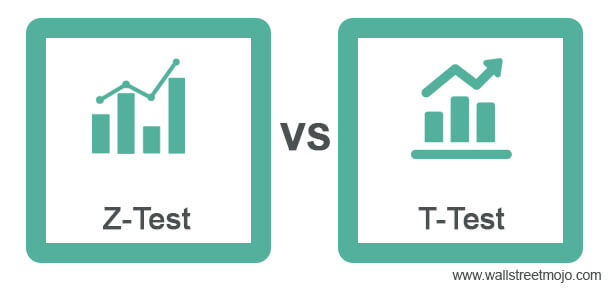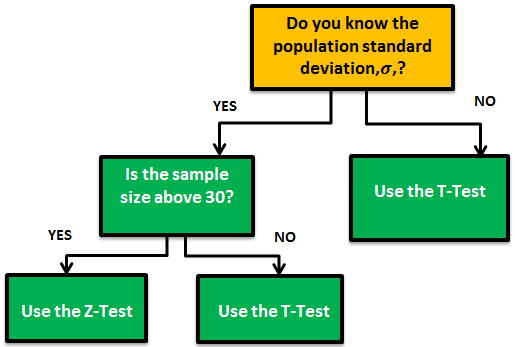How to Read a T Test in Excel
Differences Between Z-Test and T-Test
Z Examination is the statistical hypothesis which is used in guild to determine that whether the two samples means calculated are different in example the standard divergence is available and sample is large whereas the T examination is used in order to determine a how averages of unlike data sets differs from each other in case standard deviation or the variance is non known.
Z-tests and t-tests are the two statistical methods that involve data analysis, which has applications in scientific discipline, concern, and many other disciplines. The t-test can exist referred to as a univariate hypothesis test based on t-statistic, wherein the mean, i.eastward., the average is known, and population variance, i.east., the standard divergence, is approximated from the sample. On the other mitt, Z-test, likewise a univariate test which is based on a standard normal distribution The standard normal distribution is a symmetric probability distribution about the average or the mean, depicting that the data near the boilerplate or the hateful are occurring more frequently than the data far from the average or the norm. Thus, the score is termed "Z-score". read more than .

You are free to use this epitome on your website, templates etc, Please provide us with an attribution link Article Link to be Hyperlinked
For eg:
Source: Z-Test vs T-Test (wallstreetmojo.com)
Uses
#1 – Z-Test
Z-test Formula Z-exam formula is applied hypothesis testing for data with a large sample size. Information technology denotes the value caused by dividing the population standard deviation from the difference betwixt the sample mean, and the population mean. read more , as mentioned earlier, are the statistical calculations that tin can be used to compare population averages to a sample's. The z-test volition tell you how far, in standard deviations Standard divergence (SD) is a pop statistical tool represented past the Greek letter 'σ' to measure the variation or dispersion of a set of data values relative to its mean (average), thus interpreting the data'southward reliability. read more terms, a data point is from the boilerplate of a data set. A z-test volition compare a sample to a defined population that is typically used for dealing with problems relating to large samples (i.eastward., n > 30). Mostly, they are very useful when the standard deviation is known.
#ii – T-Test
T-tests A T-test is a method to identify whether the ways of ii groups differ from ane another significantly. It is an inferential statistics approach that facilitates the hypothesis testing. read more than are likewise calculations that can be used to test a hypothesis, just they are very useful when we need to determine if there is a statistically meaning comparison between the 2 contained sample groups. In other words, a t-test asks whether the comparing betwixt the averages of 2 groups is unlikely to have occurred due to random chance. Normally, t-tests are more appropriate when dealing with problems with a limited sample size The sample size formula depicts the relevant population range on which an experiment or survey is conducted. It is measured using the population size, the critical value of normal distribution at the required confidence level, sample proportion and margin of error. read more (i.east., northward < thirty).
Z-Test vs. T-Test Infographics
Here we provide you with the top 5 differences between the z-test vs. t-test you must know.

You are gratis to use this image on your website, templates etc, Please provide usa with an attribution link Article Link to be Hyperlinked
For eg:
Source: Z-Test vs T-Test (wallstreetmojo.com)
Key Differences
- One of the essential atmospheric condition for conducting a t-test is that population standard deviation or the variance is unknown. Conversely, the population variance formula Population variance can be calculated using this formula: σ2 = ∑ni=one (eleven – μ)ii / N, where, σ2 is population variance, x1, x2, x3,…..xn are the observations, N is the number of observations and µ is the mean of the information prepare. read more , equally stated above, should be assumed to be known or be known in the case of a z-test.
- The t-exam, every bit mentioned earlier, is based on educatee's t-distribution The formula to calculate T distribution is T=x¯−μ/southward√N. Where x̄ is the sample mean, μ is the population mean, south is the standard difference, North is the size of the given sample. read more . On the contrary, the z-exam depends upon the assumption that the distribution of sample means will be normal. Both the normal distribution and student'due south t-distribution appears the same, every bit both are bong-shaped Bell Curve graph portrays a normal distribution which is a type of continuous probability. It gets its proper noun from the shape of the graph which resembles to a bell. read more and symmetrical. However, they differ in one of the cases that in at-distribution, there is lesser infinite in the center and more in their tails.
- Z-test is used as given in the to a higher place table when the sample size is large, which is n > 30, and the t-exam is appropriate when the size of the sample is not big, which is minor, i.eastward., that north < 30.
Z-Examination vs. T-Test Comparative Table
| Basis | Z Examination | T-Test |
|---|---|---|
| Bones Definition | Z-test is a kind of hypothesis test which ascertains if the averages of the ii datasets are dissimilar from each other when standard divergence or variance is given. | The t-examination can be referred to as a kind of parametric examination that is applied to an identity, how the averages of two sets of data differ from each other when the standard deviation or variance is not given. |
| Population Variance | The Population variance or standard deviation is known hither. | The Population variance or standard deviation is unknown here. |
| Sample Size | The Sample size is large. | Hither the Sample Size is small. |
| Key Assumptions |
|
|
| Based upon (a blazon of distribution) | Based on Normal distribution Normal Distribution is a bell-shaped frequency distribution curve which helps describe all the possible values a random variable can have within a given range with most of the distribution expanse is in the middle and few are in the tails, at the extremes. This distribution has two key parameters: the mean (µ) and the standard deviation (σ) which plays a key office in avails return adding and in chance management strategy. read more than . | Based on Student-t distribution. |
Conclusion
By and to the larger extent, both these tests are almost similar, only the comparing comes merely to their conditions for their application, meaning that the t-test is more advisable and applicable when the size of the sample is not more than than thirty units. However, if it is greater than thirty units, one should use a z-test. Similarly, in that location are also other weather condition, which will make it clear that which test is to be performed in a situation.
Well, there are likewise dissimilar tests like the f test, two-tailed vs. unmarried-tailed, etc., statisticians must be conscientious while applying them after analyzing the state of affairs and so deciding which one to utilise. Below is a sample chart for what we discussed above.

Recommended Manufactures
This article has been a guide to Z-Test vs. T-Test. Here nosotros discuss the top 5 differences between these hypothesis testing along with infographics and a comparative table. Y'all may likewise have a look at the following articles –
- What is Hypothesis Testing?
- Formula of F-Test
- Logical Test in Excel (AND, OR, IF)
- How to do F-Test in Excel?
Source: https://www.wallstreetmojo.com/z-test-vs-t-test/
0 Response to "How to Read a T Test in Excel"
Post a Comment